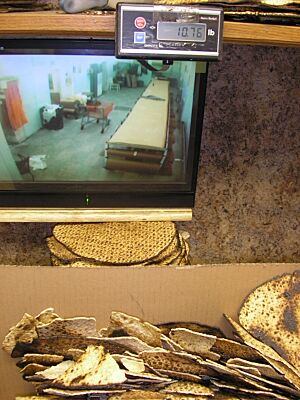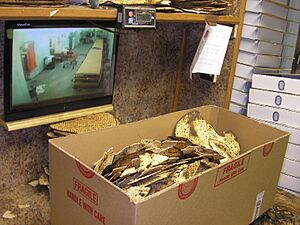Dough offering facts for kids
In Judaism, the dough offering (also called mitzvat terumat challah) is a special rule. It asks the owner of bread dough to give a small part of it to a kohen (a Jewish priest). This rule starts when the dough is kneaded. But you can also separate the offering after the bread is baked. This offering is one of the special gifts given to the priests. According to the Hebrew Bible, this rule is mainly for the Land of Israel. But Jewish teachers (rabbis) later said it also applies to bread made outside of Israel.
Today, many Jewish people burn the small piece of dough. This is because it's meant for the Kohen. However, outside of Israel, it is allowed to give the challah to a Kohen to eat. Some even encourage this.
Contents
The Dough Offering in the Bible
The idea for this offering comes from the Book of Numbers in the Bible. It says:
When you enter the land where I bring you, then it shall be, that when you eat of the food of the land, you shall lift up an offering to the Lord. Of the first of your dough you shall lift up a cake as an offering.
The word "cake" here is challah in Hebrew. "Of dough" is ʿarisah. When Jewish people returned from being exiled in Babylon, they started following many rules again. The dough offering was one of them.
Rules from Ancient Jewish Teachers
The Mishnah and Talmud are important Jewish texts. They have a whole section called Challah that talks about this offering.
Which Grains Need the Offering?
Only dough made from five types of grain needs this offering. These are wheat, barley, spelt, wild barley (or oats), and rye.
Special Cases for Dough
Some types of dough do not need the offering. For example, dough made into thin batter and deep-fried, like fritters. Also, dough mixed with milk and honey that is deep-fried, like honey-cakes. These foods still need other offerings, but not the dough offering.
If these foods were baked in an oven instead of fried, they would need the offering. If you make a lot of dough, about 1.6 kilograms or more, for hard biscuits, it also needs the offering.
Jewish Law (Halakha) Today
The Jewish laws for the mitzvah (commandment) of challah are found in books like the Shulchan Aruch and Mishneh Torah.
Two Parts of the Mitzvah
The mitzvah of challah has two main parts:
- Separating the required dough (Hafrashat challah).
- Giving the dough to a Kohen (Netinat Challah).
Some Jewish scholars say that giving the dough to the Kohen is the most important part.
The owner of the dough is responsible for separating Challah. This rule does not apply to very small amounts of dough. It also doesn't apply to bread made for animal feed. Even though the Bible mentions "bread of the land" (meaning Israel), Jewish teachers say this rule should be followed in other countries too.
How Much Dough?
Jewish teachers decided the smallest amount of dough that needs the offering. It's about 1.64 kilograms of flour. If you use this much, you say a special blessing. If you use between 1.23 kg and 1.666 kg, you separate the dough but don't say the blessing.
How Much to Give?
The Bible doesn't say how much dough to give. Jewish teachers decided that private individuals should give 1/24 of the dough. Large bakeries give 1/48. If a baker forgets to separate the Challah before baking, they can do it after the bread is baked.
Other Details
This rule applies in Israel even during the Shmittah year. This is a special year when the land rests. Even a poor person who gets other gifts is still required to give Challah.
Modern Practice of the Mitzvah
Today, in Israel, Kohanim are not allowed to eat the Challah offering. This is because of rules about ritual purity. However, Jewish teachers encouraged people to keep separating Challah. This helps make sure the mitzvah is not forgotten. When separating the dough, a special blessing is said.
Many Jewish people outside of Israel burn the Challah piece. Home bakers often toss it to the back of the oven. But it is allowed to give the separated Challah to a Kohen to eat. Some rabbis even encourage this. The Kohen must be ritually pure to eat it. In Yemen, people would burn one small loaf for Challah. They would also give another small loaf from the same batch to a Kohen child to eat. This helped keep the tradition alive.
If you forget to separate the dough while cooking, you can still do it later. But you don't say the blessing.
Passover Challah from Matzah
Some Jewish communities have a custom to give Challah from the dough used for Passover matzah. They give this fully baked matzah to a Kohen child to eat.
Kohanim in different countries have asked Jewish communities to do this more often. They say it helps people remember the important part of the mitzvah of challah: actually giving it to the Kohen.
Daily Challah Yield from Bakeries
In 2011, there were about 13 special matzah bakeries outside of Israel. Here is how much Challah they produced each day:
| Shmurah Matzah Bakery | Approximate Daily Challah Yield |
|---|---|
| Shotzer | 9.0 pounds (4.1 kg) |
| Crown Heights | 10.5 pounds (4.8 kg) |
| Borough Park | 10.0 pounds (4.5 kg) |
| Chareidim (Belz) | 9.0 pounds (4.1 kg) |
| Puppa | 9.0 pounds (4.1 kg) |
| Satmar (Brooklyn) | 7.0 pounds (3.2 kg) |
| Kerestier | 7.0 pounds (3.2 kg) |
| Satmar (Monroe) | 8.0 pounds (3.6 kg) |
| Montreal | 9.0 pounds (4.1 kg) |
| Monsey | 6.0 pounds (2.7 kg) |
| Lakewood | 8.0 pounds (3.6 kg) |
| Kiryas Yoel | 7.0 pounds (3.2 kg) |
| Shotzer | 8.0 pounds (3.6 kg) |



